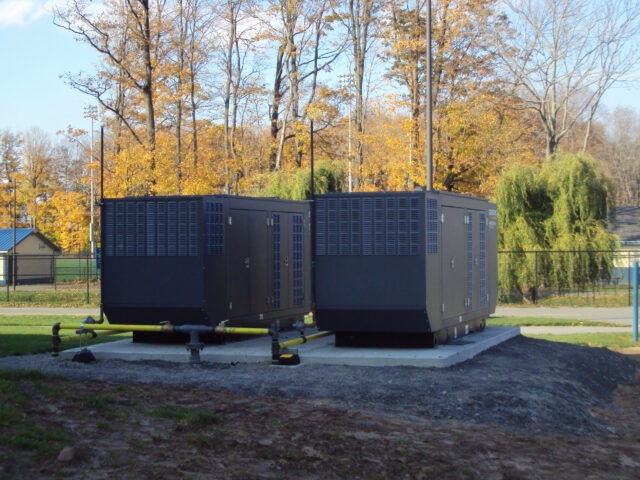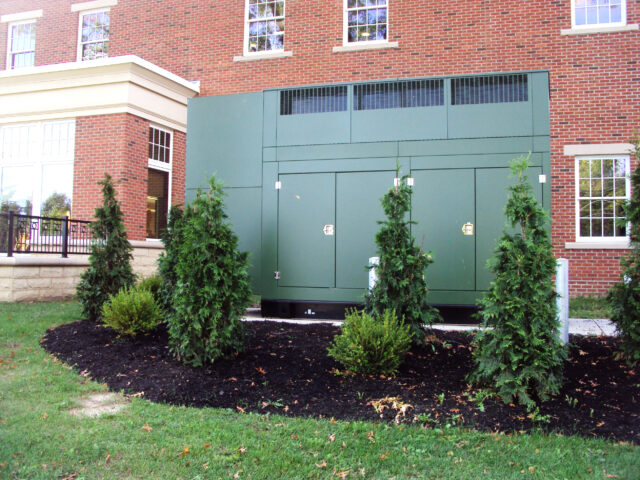Talkin’ ‘Bout Backup Generation


A guide to permanent backup power generation for your facility.
We’ve all been home, or at work, when the power goes out; and the first question that most of us think is, “I wonder how long it will take for power to come back on?” What starts off as an inconvenience or annoyance can quickly become more serious when freezers start to defrost, basements start taking on water, or we cannot heat our homes in the winter. In certain circumstances, not having electricity can pose some serious hazards.
According to the U.S. Energy Information Administration, electrical utilities serve approximately 145 million customers. In 2016, on average and including major events, each electrical customer in the country experienced 1.3 interruptions and was without power for a total of four hours during the year. On the surface, this barely looks like a problem; most of us would have little trouble dealing with not having electricity for four hours over the course of a year (or 20 minutes per month). However, there’s more to this statistic.
- Outages vary greatly by state in both frequency and duration. New York and Nebraska are states with both the lowest average number of outage instances (less than one per year) as well as the shortest total duration (less than two hours). West Virginia is home to the highest number of outage instances (just over two per year) as well as the longest total duration (just under ten hours)

- Extreme events can skew things disproportionately. If your facility is located in an area subject to hurricanes, tornadoes, flooding, or other similar events these can increase your probability for an outage event. The vast majority of the average outage duration experienced in both North Carolina and South Carolina in 2016 were attributed to major events. In the case of South Carolina, one event (Hurricane Matthew) was noted.
- Things happen every day that cause power outages – wildlife touches at least one thing it shouldn’t touch, vegetation grows until it becomes an electrical path from something energized to ground, or a car leaves the road and takes out a utility pole. Most outages are relatively minor, localized, and corrected quickly. As an example, let’s say a utility serves one million customers. Over the course of a year:

- Tabulating the information above, the average customer experienced:
- 2.05 outages (even though 250,000 customers experienced zero outages).
- That lasted a total of 9.8 hours (127 hours/13 outages)
Every day we take our chances, and sooner or later the power will go out. Why should I have permanent backup power generation?
It is always prudent to plan for eventualities, and having backup generation is one approach for a facility to deal with loss of the normal utility electric service. Making the business case for backup generation involves analyzing the economics: not having electricity has costs (loss of productivity, for example) but backup generation also has costs (first time installation costs, ongoing maintenance costs, and operating costs).
Do I backup everything, or just some things?
Alright, so you’ve made the decision: backup generation is the way you want to go, or at least explore in more detail. An understanding of how you want to operate your facility during an outage is needed so a system sizing exercise, or exercises, can be undertaken. Some common elements that are prioritized include:
- Building heating (boilers, water circulation pumps, controls) – when power goes out in the winter, keeping a building from freezing may be a priority
- Refrigerators, freezers, and similar food storage equipment
- Sump pumps and sewage ejector pumps – basements filling with water, or less sanitary materials, may be something we try to keep from happening
- An office space for maintaining critical operations
- Paging and other building communications systems
- Security and surveillance systems
Some basic questions we can ask ourselves during a power outage include:
Do we want to operate our facility as usual (or near-usual), or are we just trying to prevent damages until the normal power is restored?
All facilities are unique, so a piecemeal approach to putting select systems on backup power may or may not be feasible. Typically, most facilities have a tipping point where it is more efficient to provide a slightly larger generator and a single, larger transfer switch to support the entire electrical service rather than providing a smaller capacity generator with possibly multiple transfer switches and multiple electrical feeders. To use a medical metaphor, sometimes it is easier, less stressful, and more cost-effective to a facility to perform macrosurgery and replace the heart; rather than performing microsurgery to replace all the heart valves and bypass all the main arteries.
What kind of fuel options are available?
Standby generators are available with a variety of fueling options that include:
- Diesel Fuel
- Natural Gas
- Propane (both liquid and vapor)
- Bi-Fuel (a combination of diesel fuel and natural gas)
Each of these is available to meet certain objectives:
- Certain facilities (hospitals, airports, and border crossing stations are examples) are required to have on-site fuel storage for a certain period of time – generally 24 to 48 hours. If this is a requirement for your facility, either diesel fuel or propane is the usual choice to meet this objective. Fuel storage tanks are almost exclusively aboveground units. The maximum hourly fuel needs of the unit coupled with the minimum duration of operation will determine the minimum tank size, and a location for the tank can be confirmed. If on-site fuel storage is not a requirement, then fueling decisions can be made based on other criteria.
- The vast majority of commercial and industrial standby power generation units sold are fueled by either natural gas or diesel fuel. All things being equal, equipment costs for 125-killowatt (kW) to 150-kW units are about the same for either fueling choice. Natural gas units smaller than 125 kW are generally less expensive than their diesel counterpart, and diesel units larger than 150 kW are generally less expensive than their natural gas twin.
- Single-unit natural gas equipment larger than 200 kW is available, but it can be quite costly due to the size of the engine needed (these would use a tractor engine block). Similarly, single-unit diesel systems with capacities in the 1-megawatt (MW) to 4-MW capacity would use a locomotive engine block. Another approach involves paralleling smaller capacity modules (which use automotive engine blocks), available in both natural gas and diesel fuel, to achieve the needed overall capacity. The smaller capacity modules also feature a shorter lead-time for production and delivery (typically 6 to 8 weeks as opposed to 16 to 20 weeks or longer).
- Additional diesel fuel storage items to be aware of:
- The purely petroleum-based diesel fuel of the past remained stable for quite some time (up to 2 years). Current bio-diesel blends have a more limited shelf life (as little as 298 days) before biological elements (bacteria/fungus) can form that can clog injectors and/or fuel filters and cause combustion problems. Regular fuel sampling and testing, and a fuel monitoring and maintenance program will be needed.
- There are United States Environmental Protection Agency (US EPA) regulations which need to be followed when storing diesel fuel on your property.
- Fuel deliveries need to be coordinated when operating for extended periods.
- When using natural gas, no fuel storage is needed – trying to store compressed or liquefied natural gas is generally impractical; but you are dependent on fuel supply from a public utility. The presence of fuel and adequate pressure are needed, otherwise the unit will either not start when initiated, or shut itself down if it is already running. Curiously, natural gas outage statistics, similar to the electrical statistics mentioned earlier, are not readily available.
- Bi-fuel units (diesel/natural gas combination) start off running like a diesel unit, and then natural gas is introduced into the airstream and the compression of diesel fuel is used to ignite the combined fuel mixture. Some diesel fuel is used continuously, mostly for ignition and lubrication, but the majority of the fuel burned is natural gas. Although these can operate as diesel-only machines (at times when the natural gas service is unavailable or inadequate), under normal operating conditions their hourly diesel fuel consumption is much less than comparable diesel-only units; and results in needing a much smaller capacity diesel storage tank.
The importance of maintenance, testing, and exercising
Generators are a lot like our cars in some respects. They have engines and they are machines that have jobs to do for us. Unlike our cars though, they may only be needed when the power goes out once or twice a year. If our cars sat in the driveway for 363 days a year, and we only went out and tried to operate them on those two days, chances are they would not start when we needed them. For all the reasons our cars don’t start (dead battery, bad starter, out of fuel, etc.), our generators might not start either.
One reason our cars are so reliable is because we use them regularly. Most generators are exercised regularly – generally weekly under no-load, and we recommend exercising the machine monthly under load. Exercising under load is important because then current flows through the alternator and the engine is operated under load. Current flowing through the alternator heats up the windings, which drives any accumulate moisture out; operating the engine under load confirms the engine is adequate for the operational situation.
The goal is to operate the system in a manner very similar to how it will be called on to operate when the power goes out. – so the owner can be confident the equipment will operate when needed. Also, since the equipment is usually exercised and tested far more frequently in a normal year than when the normal utility is offline, any system failures will likely be experienced during testing or exercising and can be corrected while the normal service is available.
Also like our cars, generators need regular maintenance to keep them performing as needed. Oil needs changing; filters need replacing, battery terminals need cleaning, and mechanisms need periodic adjustments. Just like with our cars, skimping on maintenance is asking for problems someday. Sooner or later, not maintaining the equipment will catch up to us.
Selecting a transfer switch that fits your needs
NFPA 110, the Standard for Emergency and Standby Power Systems, defines an Emergency Power Supply System (EPSS) to include the source of electric power (generator) and the transfer equipment, among other components. We’ve talked about the generating equipment a bit, so now let’s continue with transfer switches.
Transfer switches are electrical power distribution components that allow a load to be supplied from more than one source by switching from one supply to another. One source is commonly the normal utility and the other is the generator. All transfer switches at this level are pretty much the same – keeping things simple, we’ll divide transfer switches into two basic categories: manual and automatic.
Manual transfer switches, as the name implies, requires someone to manually operate them; when the power goes out, they just sit there and blissfully do nothing. They require direct, human interaction to operate them.
Automatic transfer switches sense the loss of voltage on the normal source, send a start signal to the generator and wait for it to produce the correct voltage and frequency, and then automatically disengage from the normal source and connect to the backup source of power. For emergency rated systems, this all happens automatically within ten seconds of the loss of the normal utility.
Automatic transfer switches fall into two basic categories: open transition and closed transition units. Open transition switches are often referred to as “break-before-make” units; they “break” the connection from the normal source before they “make” the connection to the alternate source. Some open transition automatic transfer switches also include a neutral position where the load is not connected to either source. Closed transition switches are the opposite; they “make” the connection to the alternate source before “breaking” the connection on the normal source.
During unplanned outages, both open and closed transition automatic transfer switches perform the same in the sense that when the power goes out, there will be some dead air while the generator starts and gets going. During planned outages, such as exercising the system under building load or transferring back to the normal utility when the power comes back on, the main advantage for closed transition automatic transfer switches is that there is no “dead air” during these transfers. The lights, and all the other loads connected to the generator, stay on. If inclement weather or some other event is approaching, the decision to put a facility on generator power before the power goes out may be considered. A closed transition automatic transfer switch can make this happen seamlessly. Closed transition automatic transfer switches are more expensive than their open transition counterparts, but the operational benefit they provide may be worth it.
Another major automatic transfer switch consideration is the need for bypass isolation. Just like generators, automatic transfer switches also need periodic maintenance and adjusting – and need to be de-energized to be worked on. When standard automatic transfer switches are de-energized, so is what they are connected to. Bypass isolation automatic transfer switches include additional components that re-route the electrical feed around the transfer module and maintain service to the connected loads while isolating the transfer module; removing electrical energy from the transfer components allows them to be worked on. These automatic transfer switches are physically much larger and more expensive than their standard automatic transfer switches counterparts. Critical facilities (hospitals, airports, border crossing stations, etc.) generally utilize bypass isolation automatic transfer switches. If maintaining operations is paramount, bypass isolation may fit the bill.
The power will go out – it’s inevitable – and there are a number of items to be aware of when considering standby power generation as one response to this situation. LaBella always strives to present a complete picture for any improvement projects so people can make an informed decision. This also minimizes the chances for any unexpected consequences. Having standby power generation for your facility certainly has benefits, but there are also costs which need to be comprehended in order to make the choice that is best for you with confidence and understanding.Chuck Lind, PE
Project Manager & Senior Electrical Engineer


About the Author
Chuck Lind, PESenior Electrical Engineer / Project Manager
Chuck has 33 years of electrical engineering experience, specializing in design, estimation, specification and field support of various projects. His responsibilities include design of lighting, fire alarm systems, communications, and power distribution systems in a range of educational, commercial, industrial, and institutional facilities. He provides supervision and coordination/training for staff development, as well as manages multiple projects for higher education and municipal clients, among others.